RCA 25215 Instruction Manual
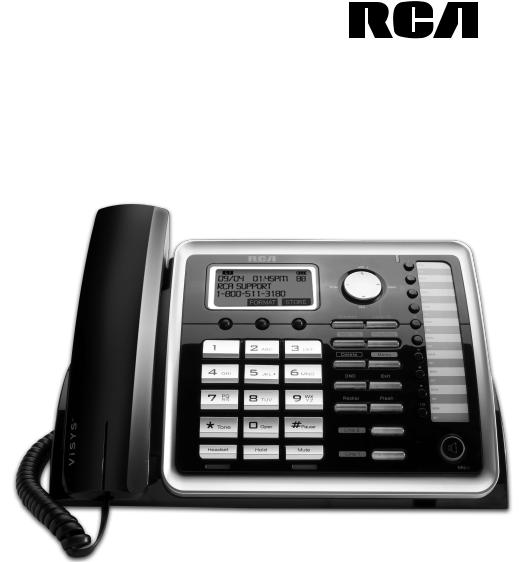
2-Line |
|
Speakerphone |
V i S Y S™ |
with Digital Answering System |
V i S Y S |
|
|
Users Guide |
|
25215

Equipment Approval Information
Your telephone equipment is approved for connection to the Public Switched Telephone Network and is in compliance with parts 15 and 68, FCC Rules and Regulations and the Technical Requirements for TelephoneTerminal Equipment published by ACTA.
1 Notification to the Local Telephone Company
On the bottom of this equipment is a label indicating, among other information, the US number and Ringer Equivalence Number (REN) for the equipment.You must, upon request, provide this information to your telephone company.
The REN is useful in determining the number of devices you may connect to your telephone line and still have all of these devices ring when your telephone number is called. In most (but not all) areas, the sum of the RENs of all devices connected to one line should not exceed 5. To be certain of the number of devices you may connect to your line as determined by the REN, you should contact your local telephone company.
A plug and jack used to connect this equipment to the premises wiring and telephone network must comply with the applicable FCCPart 68 rules and requirements adopted by the ACTA. A compliant telephone cord and modular plug is provided with this product. It is designed to be connected to a compatible modular jack that is also compliant. See installation instructions for details.
Notes
•This equipment may not be used on coin service provided by the telephone company.
•Party lines are subject to state tariffs, and therefore, you may not be able to use your own tele phone equipment if you are on a party line. Check with your local telephone company.
•Notice must be given to the telephone company upon permanent disconnection of your telephone from your line.
•If your home has specially wired alarm equipment connected to the telephone line, ensure the installation of this product does not disable your alarm equipment. If you have questions about what will disable alarm equipment, consult your telephone company or a qualified installer.
US Number is located on the cabinet bottom
REN number is located on the cabinet bottom
2 Rights of the Telephone Company
Should your equipment cause trouble on your line that may harm the telephone network, the telephone company shall, where practicable, notify you that temporary discontinuance of service may be required. Where prior notice is not practicable and the circumstances warrant such action, the telephone company may temporarily discontinue service immediately. In case of such temporary discontinuance, the telephone company must: (1) promptly notify you of such temporary discontinuance; (2) afford you the opportunity to correct the situation; and (3) inform you of your right to bring a complaint to the Commission pursuant to procedures set forth in Subpart E of Part 68, FCC Rules and Regulations.
2

The telephone company may make changes in its communications facilities, equipment, operations or procedures where such action is required in the operation of its business and not inconsistent with FCC Rules and Regulations. If these changes are expected to affect the use or performance of your telephone equipment, the telephone company must give you adequate notice, in writing, to allow you to maintain uninterrupted service.
Interference Information
This device complies with Part 15 of the FCC Rules. Operation is subject to the following two conditions: (1) This device may not cause harmful interference; and (2) This device must accept any interference received, including interference that may cause undesired operation.
This equipment has been tested and found to comply with the limits for a Class B digital device, pursuant to Part 15 of the FCC Rules. These limits are designed to provide reasonable protection against harmful interference in a residential installation.
This equipment generates, uses and can radiate radio frequency and, if not installed and used in accordance with the instructions, may cause harmful interference to radio communications. However, there is no guarantee that interference will not occur in a particular installation.
If this equipment does cause harmful interference to radio or television reception that can be determined by turning the equipment off and on, the user is encouraged to try to correct the interference by one or more of the following measures.
•Reorient or relocate the receiving antenna (that is, the antenna for radio or television that is “receiving” the interference).
•Reorient or relocate and increase the separation between the telecommunications equipment and receiving antenna
•Connect the telecommunications equipment into an outlet on a circuit different from that to which the receiving antenna is connected.
If these measures do not eliminate the interference, please consult your dealer or an experienced radio/television technician for additional suggestions. Also, the Federal Communications Commission has prepared a helpful booklet, “How to Identify and Resolve Radio/TV Interference Problems.” This booklet is available from the U.S. Government Printing Office, Washington, D.C., 20402. Please specify stock number 004-000-00345-4 when ordering copies.
Notice: The changes or modifications not expressly approved by the party responsible for compliance could void the user’s authority to operate the equipment.
Licensing
Licensed under US Patent 6,427,009.
Hearing Aid Compatibility
This telephone system meets FCC standards for Hearing Aid Compatibility.
3

Table of Contents
Equipment Approval Information |
2 |
Interference Information |
3 |
Licensing |
3 |
Hearing Aid Compatibility |
3 |
Introduction |
5 |
Parts Checklist |
5 |
Telephone Jack Requirements |
6 |
Important Installation Guidelines |
6 |
Phone Layout |
7 |
Installing the Phone |
8 |
Programming the Phone |
11 |
- Standby Screen |
11 |
- Programming Functions |
11 |
- Answering System |
11 |
- Answer Mode |
11 |
- Record OGM |
11 |
- Settings |
12 |
- Ring Delay |
12 |
- Set Office Time |
12 |
- Set Work Hours |
13 |
- Set After Hours |
13 |
- Call Screening |
13 |
- Remote Access |
13 |
- Change Pin |
14 |
- Voice Mail |
14 |
- Call VM |
14 |
- Settings |
14 |
- Phone Settings |
15 |
- Date/Time |
15 |
- Set Date/Time |
15 |
- Set Format |
15 |
- Time Format |
16 |
- Date Format |
16 |
- Sound Settings |
16 |
- Ring Tones |
16 |
- Key Tone |
16 |
- Dial Mode |
17 |
- Area Code |
17 |
- 2nd Call Alert |
17 |
- Restore Setting |
17 |
- Display Setting |
18 |
- Language |
18 |
- Contrast |
18 |
- Backlight |
18 |
Telephone Operation |
19 |
- Making Calls with the Corded Handset |
19 |
- Making Calls in Speakerphone Mode |
19 |
- Making Calls with the Optional |
19 |
Wired Headset |
|
- Pre-Dialing |
19 |
- Answering a Call |
20 |
4
- Switching Between the Speakerphone, |
20 |
Handset, and Headset Mode |
|
- Mute |
20 |
- Do Not Disturb |
20 |
- Flash |
21 |
- Inserting a Pause in the Dialing |
21 |
Sequence |
|
- Redial |
21 |
- Reviewing the Redial Numbers |
21 |
- Storing a Redial Record in Directory |
21 |
- Ringer On/Off and Ringer Volume |
22 |
- Speakerphone, Handset and |
22 |
Headset Volume |
|
- Hold |
22 |
- Conference Calls |
22 |
Answering System Operation |
23 |
- Answering System On/Off |
23 |
- Recording Incoming Messages |
23 |
- Monitoring Incoming Calls |
23 |
- Memo Record |
23 |
- Message/Memo Playback |
23 |
- Erasing Messages |
24 |
- Remote Access |
24 |
- Memory Full |
24 |
Caller ID (CID) |
25 |
- Receiving and Storing CID Records |
25 |
- Reviewing CID Records |
25 |
- Saving a CID Record to the Phone |
25 |
Directory |
|
- Deleting a CID Record |
26 |
- Deleting All Call Records |
26 |
- Dialing Back |
26 |
- Call Waiting Caller ID |
27 |
Directory and One-Touch Memory |
27 |
- Adding Directory Entries |
27 |
- Storing a Record in the One-Touch |
28 |
Memory Buttons |
|
- Reviewing Directory Records |
28 |
- Editing a Name or Number Stored in |
28 |
the One-Touch/Memory Log |
|
- Reviewing Record in One-Touch Memory |
29 |
- Editing a Directory Record |
29 |
- Deleting a Directory Record |
29 |
- Deleting All Directory Records |
29 |
- Dialing a Directory Record |
29 |
- Dialing a One-Touch/Memory Record |
30 |
- Display Messages |
30 |
Backup Battery Operation |
31 |
Troubleshooting Guide |
31 |
General Product Care |
31 |
Warranty Assistance |
32 |
Limited Warranty |
32 |
Accessory Information |
34 |
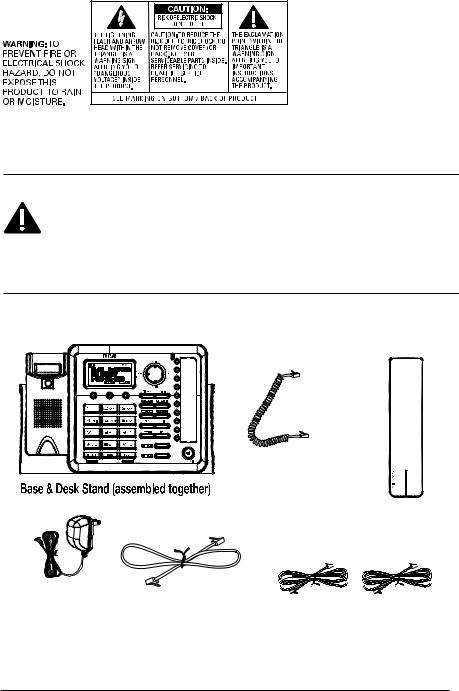
Introduction
CAUTION: When using telephone equipment, there are basic safety instructions that should always be followed. Refer to the IMPORTANT SAFETY INSTRUCTIONS provided with this product and save them for future reference.
Parts Checklist
Make sure your package includes the following items:
Coiled Handset
Cord
Corded
Handset
AC power |
Short Line Cord |
Telephone |
|
adaptor |
|||
|
2- Line cords |
||
(for base) |
|
||
|
|
5
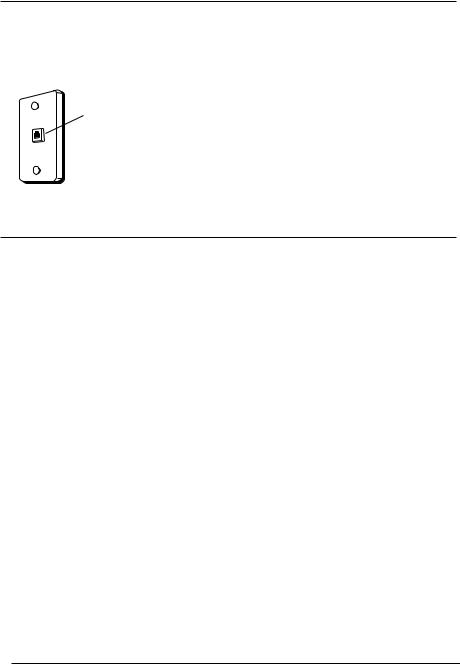
Telephone Jack Requirements
To use this phone, you will need a RJ11C (for a single line) or a RJ14C (for two lines) type modular phone jack, which might look like the one pictured here, installed in your home or office. If you find don’t have either modular jack, call your local phone company to find out how to get one installed.
Wall plate
Modular telephone line jack
Important Installation Guidelines
•Avoid sources of noise and heat, such as motors, fluorescent lighting, microwave ovens, heating appliances and direct sunlight.
•Avoid areas of excessive dust, moisture and low temperature.
•Never install telephone wiring during a lightning storm
•Never install telephone jacks in wet locations unless the jack is specifically designed for wet locations.
•Never touch non-insulated telephone wires or terminals, unless the telephone line has been disconnected at the network interface.
•Use caution when installing or modifying telephone lines.
6
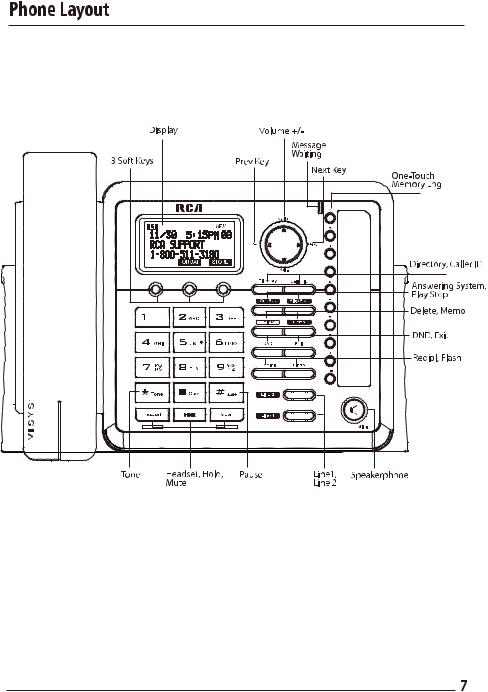

Installing the Phone
The phone may be connected by a single two-line cable or two single line cables.
1.Choose an area near an electrical outlet and a telephone wall jack (RJ11C), and place your cordless telephone on a level surface, such as a desktop or tabletop, or you may mount it on the wall.
2.Install 5 AAA-size alkaline batteries (not included) for back up power in the event of a power failure.
•Insert a flat-head screwdriver or similar object into the battery door latch and gently pry upward to release the battery door from the base.
•Insert the batteries inside the battery compartment as shown on the diagram.
••Snap the battery compartment door back into place.
NOTE: If the low battery icon appears in the display, you need to replace the batteries. It is impor-
tant that you replace them as soon as possible to maintain unit operation when electrical power is off. As a precaution, you may want to write down any stored information you do not want erased. IMPORTANT: If you are not going to use the telephone for more than 30 days, remove the batteries because they can leak and damage the unit.
3. Plug the power supply cord into the power jack on the back of the base and the other end into an electrical outlet.
CAUTION: To reduce risk of personal injury, fire, or damage use only the T-2757 (base) power adaptor listed in the user’s guide. This power adaptor is intended to be correctly orientated in a vertical or floor mount position.
4. Connect the telephone line cords:
If you have 2 single-line wall jacks installed in your home or office, you can use adaptors/couplers (not included) to combine the 2 single telephone lines into 1 dual lines. The adaptor/coupler may look similar to the one pictured here and can be purchased from your local telephone products retailer.
8

Or, you can use the 2 single telephone lines plug into the 2 jacks on the back of the telephone.
Line 2 |
Line 1 |
If you have Line 1 and Line 2 wired into one wall jack in your home or office, you can use one of the supplied telephone line cords to connect from the wall jack to the Line 1 + 2 jack on the back of the phone as shown below.
Line 1 + 2
5. If you want to mount the telephone on the wall, you can plug the 2 lines such as the below drawing;
Line 2 |
Line 1 |
9
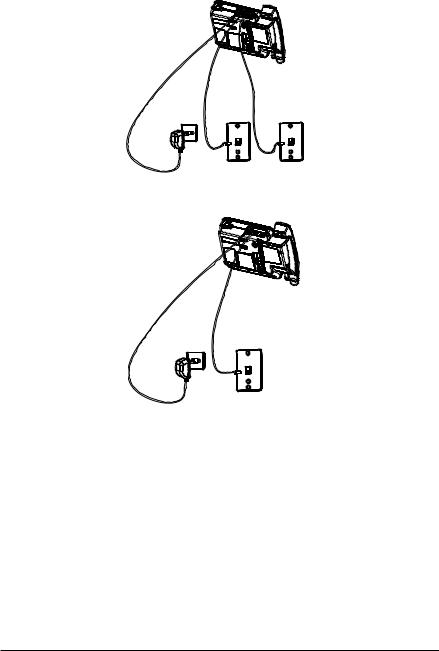
-OR-
Line 2 |
Line 1 |
-OR-
Line 1 & 2
6. Connect the handset cord:
Connect one end of the coiled handset cord to the jack on the side of the base and the other end into the jack in the handset, and place the handset in the cradle.
10
